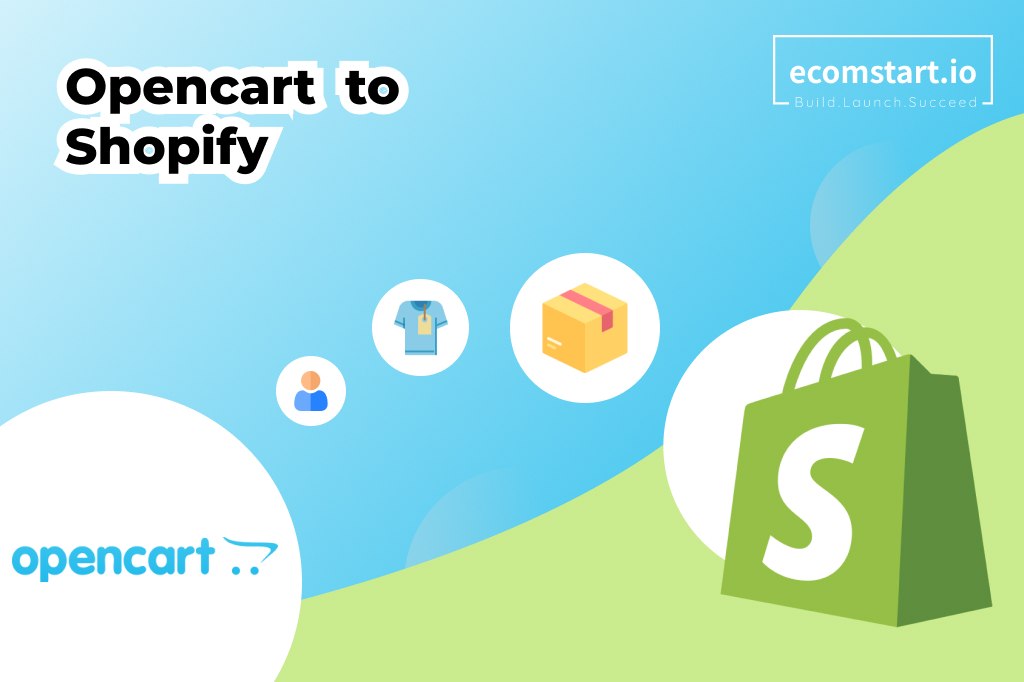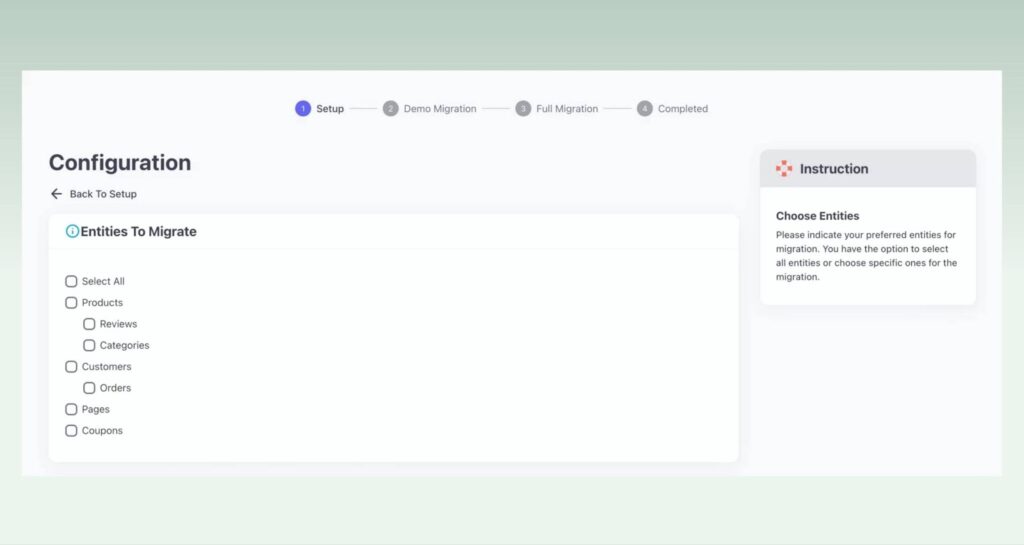OpenCart to Shopify Migration: Everything you need to know

The Opencart to Shopify migration may seem overwhelming, but it is not as complicated as it appears. This process mainly comes into the picture for people who want to use the advanced features of Shopify.
In this article, we will help you demystify migration and make it possible for you to manage it through each step. We collected tips from reliable sources to ensure that you get a complete guide that addresses your problems in a detailed way and provides solutions to possible inconveniences. This guide is a must-read for those who wish to switch. It is a valuable resource for anyone contemplating change.
Let’s begin your prosperous journey to migrate OpenCart to Shopify.
1. Benefits of OpenCart to Shopify migration

Let’s begin by getting familiar with the OpenCart and Shopify concepts before heading into the OpenCart to Shopify migration. OpenCart is an open-source platform that you have to install and configure on your web server, unlike Shopify, which comes as a standard service-based platform with certain apps.
Switching to Shopify offers several benefits. To assist you, here are the key advantages of opting to transfer OpenCart to Shopify.
- Shopify is a service-based platform. In comparison, Shopify takes responsibilities off your shoulders. It’s a one-stop shop where they handle everything from server maintenance to security updates, letting you focus on what matters most: business expansion.
- User-friendly interface: Shopify is an industry-recognized platform whose dashboard is well-designed, beautiful, and very simple to master. It ensures that you have full control over your eCommerce store.
- Wide range of functionalities: Shopify’s advanced application ecosystem will enable you to take your usual eCommerce sessions to the next level.
- Data preservation during migration: The migration process requires exporting data from OpenCart containing products, orders, customers, and other important eCommerce data and safely transferring it to Shopify.
- Improved store performance: When you migrate to Shopify, you can expect optimization of the business operations, robust processes, and ultimately better store performance.
In summary, an Opencart to Shopify migration is a beneficial option with many advantages, making it worth considering in light of your eCommerce needs.
2. What data can be migrated during an Opencart to Shopify migration?
The decision to transfer OpenCart to Shopify is a strategic turning point for any online business. It entails transferring the crucial data from your OpenCart store to Shopify. Let’s go through the migration to comprehend what sort of information can be transferred.
When you decide to migrate OpenCart to Shopify, several vital data types are moved:
- Products: All product-specific details, images, variants, and related info are fetched.
- Customers: The migration process will create a backup of your customer details, which may include their names, emails, and contact information.
- Orders: Both the history of previous buyers’ order information, including products purchased and quantities and prices, go to the new platform.
- Blog Posts: Even if you have an OpenCart blog linked to your store, these blog entries can be transferred to your new online store.
In conclusion, when you decide to migrate OpenCart to Shopify, not only do you bring with you your products, customers, orders, and even blog posts, but you also get a chance to improve your online store’s functionality and performance. This tactical move eliminates the chances of missing critical data when upgrading to an intuitive and scalable platform.
Read more: Shopify vs OpenCart: What’s the Perfect Fit for Your Business?
3. What are the methods to migrate from OpenCart to Shopify?
Among the three choices for OpenCart to Shopify migration, you must choose what will work well for your business. Let me give a quick rundown of each so that you can pick the right one for your requirements:

- Manual Transfer: To properly implement this method, you must manually go through your data from OpenCart to Shopify. On the other hand, CSV files can also serve the same purpose. You don’t need special technical skills to choose this solution, but preparing for this method can take much work.
- Third-Party Services: The wide range of services that help with the migration is phenomenal. Such services may achieve data accuracy and consistency within a given time frame. Nonetheless, they still require a price to be paid most of the time.
- Hiring an Expert: If you are not interested in doing this (or not experienced) by yourself, you can search for this expertise to help you. These experts can be in charge of a whole process from the beginning till its triumphant finish. Nevertheless, this is the most costly approach.
Finally, all of these methods offer a different migration approach for your OpenCart website to Shopify, depending on the resources you have. As a result, you choose the one that you prefer most.
4. Step-by-step guide: How can you seamlessly migrate from OpenCart to Shopify?
Putting your e-commerce store in transition must be an extremely exhausting thing to do. On the other hand, when equipped with a walk-through guide and careful planning, OpenCart to Shopify migration can be a pain-free experience. Here are the pre-migration steps you should take:
4.1. Pre-migration
- Backup Your Store: First, you must prepare a backup of your OpenCart store beforehand in case anything bad happens to your data and you can’t restore it. This is an insurance policy that will keep your store unharmed even if the migration process is unsuccessful.
- Set Up Your New Shopify Store: Start creating your new shop. Although Shopify provides a trial, it is advisable to select the entire plan to get all the features needed for a successful migration.

If you implement the present pre-migration measures, you will have established the right foundation for a successful Opencart to Shopify migration. Bear in mind that deliberate planning is essential to a successful migration.
4.2. Migration process
You’ve finally finished prepping up your stores; now, you can migrate OpenCart to Shopify. Here are the steps you’ll follow manually or using a third-party app.
4.2.1. Manual migration:
Step 1: Export Your Data from OpenCart: Log into the admin area of OpenCart. On the’ System’ tab, find the ‘Export’ / ‘Import’ button. You can now download all the data (customers, products, and orders) in CSV format.

- Step 2: Import Data to Shopify: Log in to your Shopify admin account to activate. Find the’ Import’ option in the menu (Products, customers, etc.). Select the CSV file you’ve exported from OpenCart and upload it. Shopify will then carry out the next stage of the process, which entails data importation of your information.
- Step 3: Transfer Product Images: This step involves transferring product images from your OpenCart store to Shopify. You may use methods like direct file transfers, cloud storage services, or even manual downloads and uploads. Ensure the images are properly linked to their respective products in Shopify.
- Step 4: Set Up Products in Shopify: Next, set up your products in Shopify. This includes creating product listings, setting prices, and adding descriptions. Make sure each product is categorized correctly for easy navigation.
- Step 5: Configure Shopify Theme: Finally, choose a Shopify theme that matches your brand’s aesthetics and configure it to your liking. Customize the layout, color scheme, typography, and other visual elements to maintain consistency with your previous OpenCart store.
4.2.2. Automated Migration with LitExtension:
With automated migration, we will use LitExtension, a third-party app as an example. This app offers an easy-to-follow automated solution for migrating your OpenCart store to Shopify. It simplifies the migration process and ensures a seamless transition. Let’s break down the steps:
- Step 1: Enter Carts’ Information:

Start by creating a new migration pair. Click on “Create New Migration” at the top right of the migration page. You’ll need to install the LitExtension Connector for OpenCart. Download the connector, extract the zip file, and upload it to your OpenCart root folder. The installation status will automatically display on your screen.
Next, select Shopify as your Target Cart Type and input its URL. Do the same for OpenCart as your Source Cart Type.
- Step 2: Choose Entities for Migration:

Now, decide what data you want to transfer. You can choose to migrate all entities or select specific data sets like products, customers, or orders.
LitExtension also offers additional options to:
- Strip HTML from category and product names
- Preserve order IDs on the target store
- Migrate categories into Shopify Smart Collections
You can also match languages, order status, and customer groups to display correspondingly in the new store. At this point, you can either start the migration process immediately or run a demo to see how LitExtension transfers your data.
- Step 3: Start Migration:
Begin your demo migration with up to 200 entities to understand the process better. If you’re confident, you can skip this step and proceed to Full Migration.
Once the migration starts, it runs seamlessly on the server. You don’t need to keep your computer on during the transfer. Once completed, you’ll receive an email notification.
And that’s it! With these steps, you can easily migrate your OpenCart store to Shopify. Whether you move the data manually or by automated tools, review all imported data for accuracy after the migration. This will guarantee a smooth transition.
4.3. Post-migration
After you have completed the OpenCart to Shopify migration, your journey doesn’t stop here. There are essential post-migration procedures to ensure a satisfactory transition.
- Review Imported Data: Check imported data for accuracy. Double-check the transferred products, customer information, and order records to ensure they are in order.
- Set Up Payment Gateways: Set up a payment gateway on Shopify. Ensure that all payment methods involved in your store are available and configured properly.

- Configure Shipping Settings: In your OpenCart shop, customize your shipping settings. Ensure that all shipping information and rates are correct.
- Test Your Store: Do a comprehensive test of your Shopify store. Give it a try by purchasing something, processing the returns, and moving through the website like a customer.
- Notify Your Customers: Inform your customers about your change via email or social media. Emphasize any changes they might experience and assure them of their data’s safe transition.
After executing this plan, your brand will still be fully functioning and your customers will have a pleasant shopping experience in your online store.
Ultimately, an Opencart to Shopify migration should be considered a wise decision, as it is an excellent strategy for eCommerce business growth. Proper implementation can considerably cut your operational costs and increase your online sales. The most important thing is to carry out your migration process precisely and follow up on each step to guarantee a hitch-free transition.
Remember that your customer’s experience should come first while changing your strategy. You will have a trustworthy partner in Ecomstart who will be alongside you every step of the way through this process. Check out our other Shopify migration guides and ecomstart.io for advanced ideas and support. Take a step forward, keep growing, and drive your business on the cutting edge of ever-changing digital marketing.


